(8) Food Security(Note34) and Nutrition
The number of chronically undernourished people in the world is estimated at 821.6 million (approximately one in nine people in the world) in 2018, according to the “2019 State of Food Security and Nutrition in the World” jointly prepared and published by the Food and Agriculture Organization of the United Nations (FAO), the International Fund for Agricultural Development (IFAD), the World Food Programme (WFP), the United Nations Children’s Fund (UNICEF), and the World Health Organization (WHO). Although the number of chronically undernourished people had been on a declining trend for more than 10 years until 2014, it has continued to rise since the trend was reversed in 2015. In order to achieve Goal 2 of the Sustainable Development Goals (SDGs), “End hunger, achieve food security and nutrition improvement, and promote sustainable agriculture,” it is vital to put in greater effort. Furthermore, climate change and extreme weather phenomenon in recent years have given rise to a severe food crisis, making it one of the important factors leading to the recent increase in the starving population. Hence, there are calls around the world to accelerate and expand action toward strengthening resilience and adaptability (see “Promotion of UHC (Japan’s Initiatives at International Conferences)” for details on UHC).
In order to achieve food security, there is a need for multifaceted measures based on international coordination. These measures include not only a sustainable increase in the production of food, but also improvement of nutrition, establishment of a social safety net(Note35), provision of necessary food assistance, and implementation of countermeasures against infectious diseases among livestock. Improving the nutritional status during the first 1,000 days from pregnancy to the child’s second birthday is said to be particularly important as it has a significant impact on the child’s long-term growth thereafter.
In establishing food security, measures toward developing the agricultural sector in developing countries is a pressing issue. Since many of the poor in developing countries live in the rural area, and the majority depend on agriculture for their livelihoods, it is important to tackle the development of agriculture and farming communities. Furthermore, many farmers in developing countries are unable to sell their agricultural products at a high price, and this, among other factors, makes it difficult for them to get out of poverty. Thus, one of the proposed solutions for this is to build a food value chain. This is an initiative in which many stakeholders, including the farmers, suppliers of the necessary farming implements such as seeds, fertilizers, and farming machinery, processing companies of agricultural produce, transportation and distribution companies, and retailers, cooperate to create a chain that can enhance the added value of agricultural produce from the stages of production, to manufacturing and processing, distribution, and consumption. The added value of agricultural produce, specifically, includes improving the quality of products, developing attractive new products, reducing transportation costs, and increasing sales opportunities by expanding the sales network.
●Japan’s Efforts
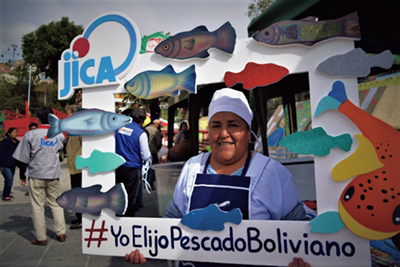
JICA Bolivia Office conducting a campaign to increase consumption of farmed Bolivian rainbow trout with the Aquaculture Center at Lake Titicaca (Photo: JICA)
Japan proactively addresses global food security issues, giving priority to cooperation for the promotion of agriculture, forestry, and fisheries, including the development of food value chains. In the short term, Japan provides food assistance to developing countries to avert food shortages, and in the medium to long term, it aims to help increase and improve agricultural production and productivity in developing countries in order to prevent and eliminate the causes of food-related problems including hunger. As its medium to long-term support, specifically, Japan uses its knowledge and experience to strengthen research and technology development, along with capacity-building in disseminating this technology in a way that is suited to the cultivation environment, promote the sustainable use of fishery resources, strengthen organizations of farmers, assist in policymaking, as well as to improve infrastructure such as irrigation facilities, farm roads, and fishing ports.
Efforts to Provide Food Assistance and Improve Nutrition
Japan is providing food assistance based on requests from developing countries confronting food shortages. In FY2018, Japan contributed a total of ¥5.11 billion as bilateral food assistance in 15 countries, and provided approximately 80,000 tons of grains (rice and wheat), which mainly include Japanese government rice.
Japan, in cooperation with international organizations, is also engaged in efforts to provide food assistance from the perspective of preventing the occurrence and recurrence of conflicts, which is a cause of starvation. For example, through WFP, Japan implements measures such as emergency food assistance, school feeding programs to improve access to education, as well as food assistance to support the self-reliance of local communities by encouraging people, through the distribution of food, to participate in the development of agricultural land and social infrastructure. In 2018, WFP conducted activities including the distribution of approximately 3.9 million tons of food to around 86.7 million people in 83 countries around the world. In 2019, Japan contributed a total of $155.23 million to WFP projects.
As for initiatives for nutritional improvement, in addition to bilateral assistance for the promotion of breastfeeding and the training of health professionals, Japan also provides assistance through multilateral cooperation by contributing to organizations such as UNICEF and WFP. Japan also participates in the international nutritional improvement initiative, Scaling Up Nutrition (SUN) as a donor country. In recent years, Japan is also putting effort into promoting nutritional improvement programs in collaboration with private companies, and launched the Nutrition Japan Public Private Platform (NJPPP) in 2016. Through this platform, in cooperation with partners from private companies, civil society, and academic research institutions, Japan contributes to nutrition improvement specifically by creating an environment that can boost initiatives of Japanese food-related enterprises, etc. for nutritional improvement in developing countries.
Japan has further intensified its efforts to improve nutrition. For example, at the 6th Tokyo International Conference on African Development (TICAD VI), Japan launched the Initiative for Food and Nutrition Security in Africa (IFNA) with the aim of accelerating nutrition improvement in Africa, and announced the expansion of IFNA’s experience and knowledge throughout the African continent to improve the nutrition of 200 million children under the age of five in Africa at the 7th Tokyo International Conference on African Development (TICAD7).

Tokyo Nutrition for Growth Summit 2020
Positioning nutrition as an important basic area for achieving Universal Health Coverage (UHC), Japan as the host country of the Tokyo 2020 Olympic and Paralympic Games will hold the Tokyo Nutrition for Growth Summit 2020. Through this summit, Japan aims to promote international initiatives for resolving malnutrition.
At the Summit, discussions on various topics related to nutrition will be conducted with a large number of stakeholders in order to resolve challenges. Specifically, the following five themes are planned to be discussed: integrating nutrition to UHC, building healthy and sustainable food systems, addressing malnutrition in vulnerable contexts, promoting data-driven monitoring (accountability), and securing financial resources for improving nutrition (see “Promotion of UHC (Japan’s Initiatives at International Conferences)” for details on UHC).
Establishment of Food Value Chains, and Promotion of Agriculture, Forestry and Fisheries
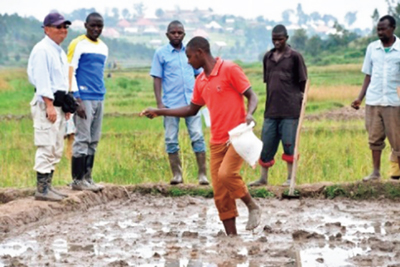
A JICA expert (left) giving instructions on how to use fertilizer in rice cultivation as part of the SHEP approach project in Rwanda (Smallholder Market-oriented Agriculture Project in Rwanda: SMAP) (Photo: JICA)
Japan is promoting the establishment of food value chains for developing countries through public-private partnership. In FY2019, Japan organized bilateral policy dialogues with Viet Nam, Cambodia, India, Brazil, and Russia. In December 2019, Japan formulated the “Plan to Promote the Establishment of Food Value Chains,” which stipulates priority initiatives for building food value chains in countries and regions throughout the world.
Moreover, with the aim of realizing food security and eradicating poverty in Africa, Japan places emphasis on agriculture as an industry that plays an important role in Africa’s economic growth, and contributes to its development. For instance, Japan supports the research of NERICA* (New Rice for Africa), a cross-breed between Asian rice and African rice, and the spread of its production techniques, as well as support for increasing rice production based on the Comprehensive Africa Agriculture Development Programme (CAADP). Moreover, at the Fourth Tokyo International Conference on African Development (TICAD IV) held in 2008, Japan established the Coalition for African Rice Development (CARD)*, and announced the CARD Initiative. Since then, Japan had established a goal of increasing rice production in Sub-Saharan Africa from 14 million tons as of 2008 to double that amount by 2018. In fact, the annual rice production in Sub-Saharan Africa (provisional value) increased to 30.1 million tons by 2017, meaning that the initial goal of doubling production has been achieved.
Furthermore, at TICAD7 in 2019, Japan announced the launch of CARD 2nd phase in order to achieve a goal of further doubling rice production in Sub-Saharan Africa (from the 2018 goal of 28 million tons to 56 million tons by 2030). Under CARD 2nd phase, efforts are strengthened toward doubling rice production by increasing the number of eligible recipient countries from 23 to 32 and adopting the RICE (Resilience, Industrialization, Competitiveness, Empowerment) approach* including efforts for enhancing the quality of locally-produced rice.
Also, in order to promote the transition from self-sufficient agriculture to income generating agricultural activities, on the occasion of the Fifth Tokyo International Conference on African Development (TICAD V) held in 2013, Japan announced the broad expansion of the Smallholder Horticulture Empowerment & Promotion (SHEP) approach* to African countries and the provision of human resources development (1,000 technical instructors and 50,000 people from smallholder organizations) through the SHEP approach. By 2018, Japan had provided training for 12,357 technical instructors and 120,085 smallholders from 29 countries, including non-African countries, toward the promotion of market-oriented agriculture.
In addition, in response to requests from African countries at TICAD VI for greater cooperation in the agricultural field, Japan has launched a platform that connects African countries and Japan. Through this platform, Japan dispatched six experienced experts from 2018 to 2019 to carry out the transfer of outstanding agricultural technology and advance human resources development as well as to promote excellent projects in the field of agriculture.
Senegal
Project for Improvement of Irrigated Rice Productivity in the Senegal River Valley (PAPRIZ2)
Technical Cooperation (April 2016 - March 2021)
Rice is one of the staple foods of Senegal, which is a leading rice consuming country in West Africa. However, domestic rice production has not kept up with demand, and the country faces the challenge of improving its self-sufficiency rate.
Japan has been continuing its cooperation for supporting the improvement of rice self-sufficiency in Senegal, and to date, has been implementing a number of rice cultivation projects, particularly in the Senegal River valley in northern Senegal, where more than 70% of the country’s domestic rice is produced.
Under this project, which has been implemented since 2016, Japan has cooperated closely with related organizations such as the Ministry of Agriculture and Rural Equipment and other central ministries and agencies to support the formulation of a medium- to long-term master plan for rice cultivation in the Senegal River valley. The Master Plan has been highly recognized by the Government of Senegal because it included reviews of agricultural development and technical assistance in the Senegal River valley and recommendations for the Government, and emphasized the importance of ownership by the Senegalese side in the formulation process. Moreover, the Master Plan has greatly contributed to Senegal’s rice cultivation policy, through its incorporation into the country’s national rice development plan.
Furthermore, Japan is providing technical supports to improve rice productivity and quality in the departments of Dagana and Podor, which are especially active in rice cultivation in the Senegal River valley. Specifically, Japan is implementing community-based cooperation to achieve (1) appropriate maintenance and management of irrigation facilities, (2) efficient dissemination of rice cultivation techniques and introduction of suitable seed cultivation methods, (3) improvement of the quality of rice polishing, moisture management for paddy and polished rice, and other appropriate post-harvest treatment, (4) enhancement of the quality of agricultural machinery servicing, and (5) promotion of double-cropping. JICA experts dispatched from Japan to Senegal who go to the fields together with local farmers and provide technical assistance have gained a great deal of trust from the people who are involved in agriculture in these communities.
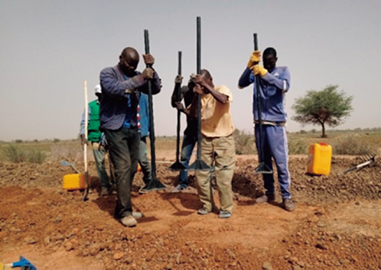
Conducting waterway compaction work as part of a farmer-participatory construction work in the department of Podor in January 2018 under the guidance of SAED (National Company of Development and Exploitation of Land in the Delta of Senegal River, and Faleme Valleys) extension officers who had received the leader’s training on maintenance and management under PAPRIZ2 (Photo: JICA)
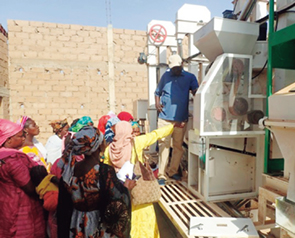
Instructing a women’s group in the department of Dagana on the operation of a rice-polishing machine in September 2018 (Photo: JICA)
Food Security through a Multilateral Cooperation Approach
Japan proposed the “Responsible Agricultural Investment (RAI)”* initiative at the G8 L’Aquila Summit (Italy) in 2009, with the aim of easing the unintentional negative impact of large-scale agricultural investment in developing countries, such as the acquisition of agricultural lands by foreign investors, against the backdrop of the need for increased food production in the world and rising international food prices. Under Japan’s initiative, the Principles for Responsible Agricultural Investment (PRAI) were formulated by FAO, IFAD, the United Nations Conference on Trade and Development (UNCTAD), and the World Bank, while the Principles for Responsible Investment in Agriculture and Food Systems (CFS-RAI) were adopted at the Committee on World Food Security (CFS) in 2014. Japan, in cooperation with relevant international organizations, promotes efforts for conducting research to facilitate “Responsible Agricultural Investment” and initiatives to share good practices in order to raise awareness and promote understanding at the regional level.
At the G7 Summit 2015 in Schloss Elmau (Germany), the G7 set an ambitious target of “aiming to lift 500 million people in developing countries out of hunger and malnutrition by 2030” and announced the “Broader Food Security and Nutrition Development Approach.” Based on this approach, the G7 also announced the “G7 Vision for Action on Food Security and Nutrition” at the G7 Ise-Shima Summit in 2016. In response to the G7 Vision for Action, Japan works on the following priority areas to achieve the target by 2030: empowering women, improving nutrition through a people-centered approach, and ensuring sustainability and resilience within agriculture and food systems. Moreover, the ministers who attended the G7 Development Ministers Meeting in 2019 discussed food security in the Sahel region, which is in a particularly serious situation, and published the Joint Paris G7/G5 Sahel Communique.
Furthermore, Japan has been involved in initiatives such as providing assistance to the Agricultural Market Information System (AMIS) in the G20, which aims to enhance the transparency of the international agricultural market. Through this inter-organizational platform launched in 2011 by the G20 as a measure to counter the wild fluctuations of food prices, the G20 member countries, major importing and exporting countries, corporations, and international organizations participate in a system for sharing information on the agricultural and food market (such as production volumes and prices) in a timely, accurate, and transparent manner. Japan has provided project costs to AMIS, while sharing information about Japan, to contribute to the enhancement of food security.
Japan also provides assistance in the agricultural sector to enable developing countries to strengthen their own foundations for food production through international organizations such as FAO, IFAD, Consultative Group on International Agricultural Research (CGIAR), and WFP, while also making contributions to the enhancement of animal hygiene through the World Organisation for Animal Health (OIE) and FAO. For example, Japan has provided assistance in technical cooperation for the agricultural and rural development of developing countries, the establishment of international standards and norms in the food and agriculture fields, and the development of statistics etc., through FAO. In addition, Japan provides support for research on the variety development conducted by CGIAR, which is comprised of 15 agricultural research institutions, and promotes collaboration with the Group through exchanges among researchers. Concerning transboundary zoonotic diseases such as foot-and-mouth disease and African Swine Fever (ASF), Japan is contributing to enhancing animal hygiene in the Asia-Pacific region, in cooperation with the OIE and FAO, through active contributions to the Global Framework for Progressive Control of Transboundary Animal Diseases (GF-TADs), which was established by those two organizations.
Bangladesh
Project for Livelihood Support to Bangladeshi Smallholder Farmers and Food Assistance to Displaced People from Myanmar
Grant Aid (Partnership with WFP) (January 2019 - January 2021)
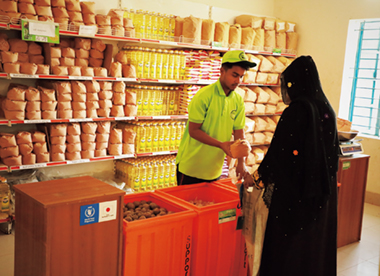
A displaced person purchasing mung beans at a grocery store in a camp for displaced persons where E-vouchers can be used (Photo: WFP)
Bangladesh has achieved remarkable economic growth in recent years. One of its important industries is agriculture, which accounts for around 40% of the country’s total labor force and a large proportion of GDP. Meanwhile, it is necessary for small-scale farmers, who account for approximately 11 million out of approximately 40 million people living in poverty in Bangladesh, to secure cash income, and thus to improve their livelihoods by growing cash crops.
Moreover, since August 2017, many displaced persons have flowed into Cox’s Bazar in southeastern Bangladesh from Rakhine State in Myanmar, and more than 900,000 people are still living in evacuation shelters. It is said that the diets of roughly half of the displaced persons are below the international poverty line*1 , and the nutritional conditions of displaced persons have been in a critical state in terms of not only amount, but also lack of dietary balance. Thus, urgent improvement is needed.
In response to this situation, Japan began to provide support in partnership with WFP from 2019 to transfer cultivation technologies for crops such as mung beans to small-scale farmers, and to provide assistance to enable displaced persons from Myanmar to purchase mung beans produced by small-scale farmers with electronic food distribution cards (E-vouchers*2). Grameen euglena and euglena Co., Ltd., which have been engaged in the cultivation of mung beans using Japanese agricultural technology in Bangladesh since 2014, are transferring the technology in partnership with WFP.
Through this cooperation, approximately 2,000 kg of mung beans have been provided to the camps for displaced persons by December 2019. Moreover, it is expected that the livelihoods of small-scale farmers and the nutritional conditions of displaced persons will be improved through the training of around 2,000 people regarding techniques for cultivation of crops such as mung beans. Furthermore, users of the E-vouchers have said that it has enabled them to purchase beans, vegetables, and various other foods, and that the mung beans they ate for the first time were delicious. These voices from the E-voucher users show the achievement of this assistance.
*1 The World Bank sets the international poverty line at $1.90 per day.
*2 A system that allows people to purchase food from grocery stores using prepaid cards.
- *New Rice for Africa (NERICA)
- NERICA is a general term for rice developed in 1994 by the Africa Rice Center (formerly West Africa Rice Development Association [WARDA]) through the hybridization of high-yield Asian rice with African rice, which is resistant to weeds, diseases and insect pests. In order for NERICA to suit the natural conditions of each region in Africa, they are characterized by (i) a higher yield, (ii) a shorter growth period, (iii) higher resistance to dryness (drought), and (iv) higher resistance to diseases and insect pests than conventional rice. Since 1997, Japan has partnered with international organizations and NGOs to provide support for research and development related to new types of NERICA, test cultivation, and increased production and popularization of seeds. In addition, Japan has dispatched agricultural experts and JOCVs to offer cultivation training, and has also accepted trainees from Africa for training in Japan.
- *Coalition for African Rice Development (CARD)
- CARD is a consultative group composed of donor countries, African regional organizations, and international organizations, partnered with rice-producing countries in Africa that are interested in rice production and development.
- *Resilience, Industrialization, Competitiveness, Empowerment (RICE) approach
- An initiative adopted under CARD 2nd phase to realize the goal of doubling rice production in Sub-Saharan Africa. Specific efforts include stabilizing production through adaption to climate change and population growth, industrial formation in local areas in cooperation with the private sector, enhancing the quality of home-grown rice so that it can compete with imported rice, and the establishment of agricultural management systems for improving the household incomes and livelihoods of farmers.
- *Smallholder Horticulture Empowerment Project (SHEP) approach
- The SHEP approach refers to an effort to assist smallholder farmers to enhance their agricultural organizations through training and research on local markets, and to provide guidance on cultivation techniques and development of agricultural roads while taking into account gender issues, in order to help them improve their capacities to manage their market-oriented agricultural businesses. Japan is supporting the adoption of SHEP in Africa.
- *Responsible Agricultural Investment (RAI)
- RAI is an initiative that aims to maximize the interest of local areas, including farmers, and investors, as well as minimize the risks to both sides, by balancing between the responses to the need to increase agricultural investment for severe poverty reduction in rural areas of developing countries and the responses to the unintentional negative impact of agricultural investment, such as a threat to various rights including food security and land ownership of the local people.
- Note 34: A state where all people, at all times, can access sufficient, safe, and nutritious food.
- Note 35: A mechanism in which people can live in safety and without difficulties.
